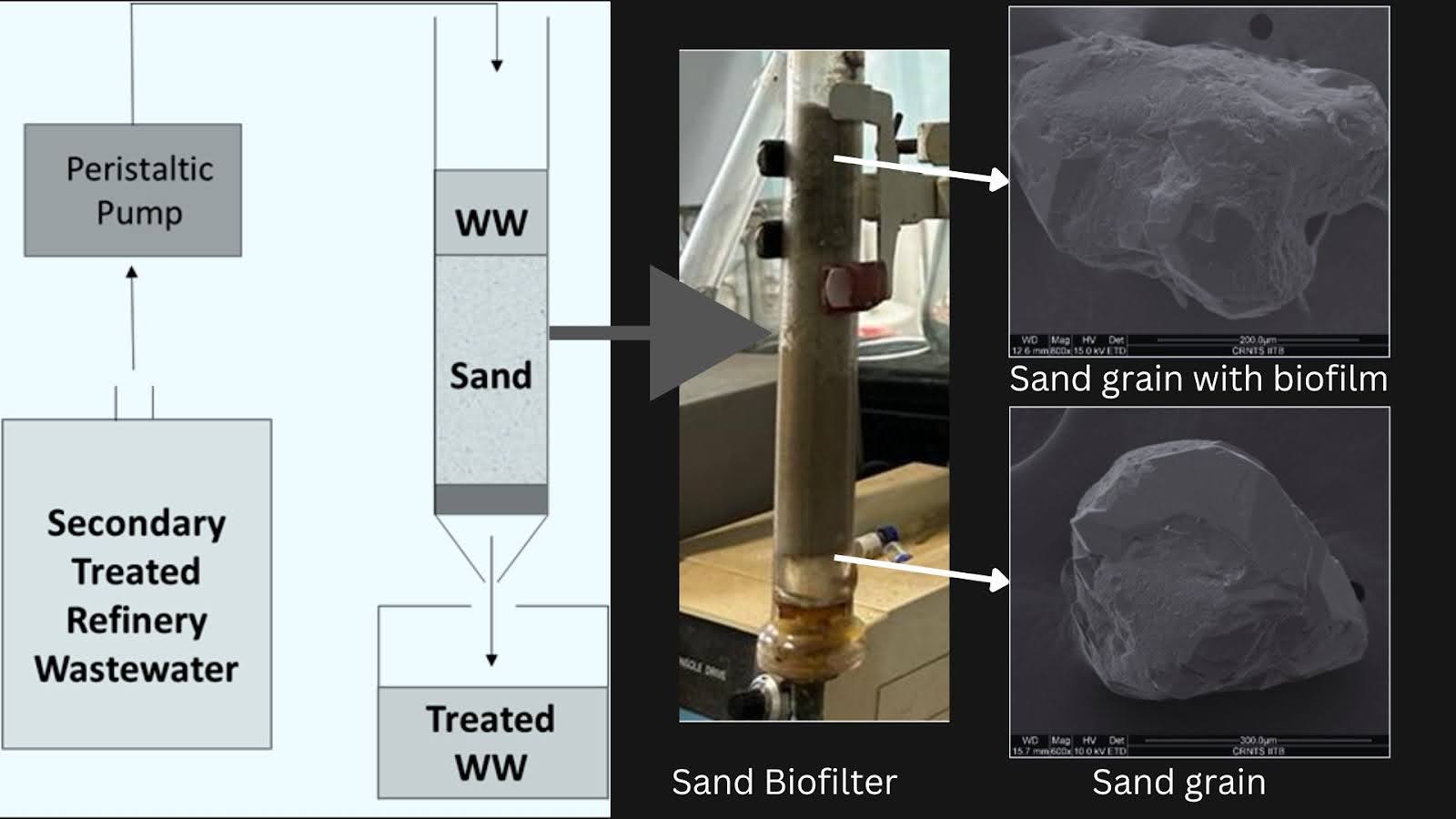
Refineries, which transform crude oil into useful products like gasoline and diesel, generate large amounts of wastewater. This water, which has been used for activities like steam generation and heat transfer, often contains harmful organic and inorganic pollutants, including nitrogen-containing compounds. The wastewater then undergoes several steps of treatment to remove most of these contaminants before it can be safely discharged into the environment. Scientists have been exploring alternative additional treatment steps that are both environmentally safe and economically viable.
A recent study by researchers at the Indian Institute of Technology Bombay (IIT Bombay) on biofilters, which are water filters that use microorganisms, like bacteria, to remove pollutants, has led to an interesting observation- partially treated wastewater from refineries already carry bacteria that can remove the organic contaminants from the wastewater. The researchers only had to provide a substratum- in this case, a column of pure quartz sand - onto which the bacteria could cling to get to work.
For their study, the researchers investigated the properties of sand as a biofilter.
“Sand was chosen since it is commonly used in deep bed filters used for water and wastewater treatment,” remarks Prof. Suparna Mukherji, from the Department of Environmental Science and Engineering, IIT Bombay, who led this study.
The researchers designed a biofilter made of an acrylic cylinder measuring 45 cm in length and 2 cm in diameter. They filled it with pure quartz sand to a depth of 15 cm. The filtration process begins by allowing secondary treated refinery wastewater, which has undergone the removal of toxic chemicals, to flow through the biofilter at a controlled rate of 1 to 10 mL per minute. The wastewater flowing through the sand leads to the formation of a biofilm, made of several different types of bacteria enmeshed in extracellular polymeric substances secreted by the bacteria, on the grains of sand.
“As the water flows through the sand bed, bacteria present in the water/wastewater get adsorbed onto the sand. Subsequently, the attached bacteria replicate and secrete extracellular polymeric substances to form a biofilm on the surface of the sand grains. Bacteria grow using dissolved oxygen, organic carbon, and other nutrients from the water flowing through the sand bed,” explains Prof. Mukherji.
This biofilm in turn eats away at the organic contaminants in the water. Degradation of organic compounds containing nitrogen releases inorganic nitrogen in the form of ammonium, which is further converted to nitrate. Although some removal of nitrate may have occurred, build-up of nitrate was observed after biofiltration.

The team analysed the Chemical Oxygen Demand (COD), Total Organic Carbon (TOC), and Assimilable Organic Carbon (AOC), which are measures of the various organic compounds in the water. Analysis of COD and TOC allows researchers to estimate the concentration of organic contaminants in the water. Remarkably, they observed a significant reduction in COD, TOC, and AOC after just two recirculations of the wastewater through the biofilter.
The team also used a technique called GCxGC TOF MS, which stands for Gas chromatography Time of Flight Mass spectrometry, to detect and quantify specific organic compounds in the water.
“Recirculating the wastewater up to 12 times resulted in maximum reduction in COD and TOC of 62% and 55%, (by more than half) respectively. GCxGC-TOF-MS revealed that several of the identified target (harmful) compounds could not be detected in the wastewater after 12 recirculations, suggesting 100% removal,” adds Dr. Prashant Sinha, an author of the study, who was pursuing his PhD from IIT Bombay at the time of the study.
The nitrates produced by the bacteria during filtration, through conversion of other forms of nitrogen, caused a build-up of nitrates in the treated water.
“The build-up of nitrates observed is not desirable. However, refineries commonly employ reverse osmosis (RO) as the final treatment step. This process can reduce the level of nitrates in the final effluent,” says Prof. Mukherji.
Biofiltration can also reduce the deposition and accumulation of unwanted material on the RO membranes by reducing AOC.
The study also delved into the biofilter’s microbial community. It turned out that the predominant bacteria belonged to a group called Proteobacteria. The group is known for their ability to break down complex organic compounds like polynuclear aromatic hydrocarbons (PAHs), which are harmful to living organisms. The Proteobacteria group includes helpful bacteria like Sphingomonadales, Burkholderiales, Rhodobacterales, and Rhodospirillales, all recognized for their role in cleaning up hazardous pollutants.
Sand biofiltration method stands out for its simplicity, meaning it could be an accessible solution for many industrial plants worldwide. It could significantly reduce the environmental footprint of oil refineries. With pure quartz sand being easily available, the overall cost of building and maintaining such a biofilter at large scales remains very low, making the filtration economical.
Prof. Mukherji, however, is already planning her next steps, saying, “We would like to explore this process further using other types of media and with different types of water/ wastewater”.






